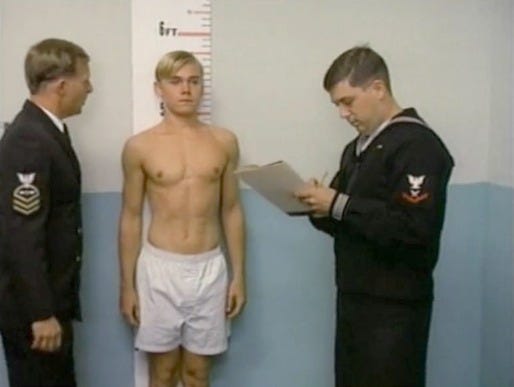Too Young the Hero (1988)

I've occasionally made exceptions to the Reeling Backward column to include television movies, and I'm doing so again for a little-known drama from 1988 called "Too Young The Hero." I'm doing so not because it's particularly well done, but because the subject material is so compelling.
Rick Schroder stars as an underage seaman serving in the U.S. Navy during World War II. What makes the story of Calvin Graham so astonishing is that he had just turned 12 when he enlisted, fabricating a notarized letter from his mother stating that he was 17. Graham served honorably — including earning two Purple Hearts and a Bronze Star for heroic actions during the Battle of Guadalcanal — before he was discovered, imprisoned and eventually discharged shortly after his 13th birthday.
He was quite possibly the youngest person to see combat in post-Civil War U.S. military history.
The TV movie shines a light on a not-too-well-hidden secret of the American military during WWII: Many of the soldiers who fought and died in defense of their country were underage. We pride ourselves upon being a "civilized" nation when it comes to war — as if there is such a thing — but as a people we were more than happy to turn a blind eye to mere boys fighting and dying in uniform.
With a little research, I learned of an estimated 300 Americans age 16 or under who died in the military during the war. With that, we can extrapolate approximately how many total boy soldiers there were.
Given that about 416,800 servicemen died out of nearly 16.6 million who served, the mortality rate for soldiers during the conflict was 2.5 percent. If the death rate was the same for underage soldiers, then that 300 dead indicates something like 12,000 enlisted men were secretly too young to serve.
In other words, about one out of every 1,385 soldiers who served during the war was concealing their age.
Even that excludes 17-year-old recruits, an age that still seems pretty appalling by modern standards. You can actually still enlist in some branches of the American military at age 17 with parental consent, although newer rules prohibit them from being stationed overseas. Nonetheless, approximately 60 soldiers who were 17 were believed to have served in Iraq and Afghanistan during 2003-04.
Schroder was a good choice to play Calvin, being about 17 at the time they started filming. Director Buzz Kulik shoots him in different ways so that he seems convincing as both a 12-year-old and as a 17-year-old. In uniform, he certainly looks like a pretty baby-faced seaman, but there were also probably a lot of 18-year-old recruits who looked much younger than they were. The officers and petty officers give him an extra look, but don't ask too many questions as he performs his duties well.
The story is told in flashback as Calvin sits and rots in a military brig, awaiting some sort of dispensation on his case, and he relates his tale to various fellow prisoners. The story concentrates largely on his efforts to get into the Navy, which are primarily economic in reason. Forced out of his mother's house by his abusive stepfather, Calvin lives with his brother on the streets for awhile until his sibling joins the Navy at age 14.
The teleplay by David J. Kinghorn is based on an unpublished manuscript by Graham and a ghost author and contains a mix of factual events and Hollywood corn. The guards at the military prison are pretty brutal to Calvin, which seems suspicious as he tells everyone he meets that he's only 12. I don't know about you, but if a very young-looking prisoner claimed he was a kid, I'd probably spare the rod a bit more than they do.
One scene is interesting and probably authentic. Calvin sees the base dentist, who takes one look in his mouth and announces that he's only 12 — because his adult molars haven't come in yet. "You've still got your baby teeth, kid!" The dentist orders him to take his file and report to the commander for discharge. Instead, while the guy's back is turned, Calvin simply drops his file in the pile of other processed recruits. It's one of those ridiculously simplistic ploys that probably would have actually worked back then.
The battle scenes aboard the battleship U.S.S. South Dakota are about what you'd expect of a TV movie — cheap-looking recreations paired together with grainy stock footage of actual WWII combat.
The last half-hour or so of the movie stumbles and fumbles, as Calvin grows more morose and attempts to contact his sister to help get him out, a strategy that eventually succeeds after she goes to the newspapers and blares out his story to the world. A very young Mary-Louise Parker plays the sister.
The TV movie actually played a role in Graham's real life. He rejoined the military as a Marine, but suffered serious injuries in a fall and was discharged. He spent decades fighting to have his dishonorable discharge from the Navy changed to an honorable one, something President Jimmy Carter did in 1978 while restoring some of his medals in the process.
A few months after "Too Young the Hero" was televised, President Ronald Reagan restored the rest of Graham's medals and disability pay amounting to just under $5,000. That's a rather cheap price for the extraordinary story of someone who served so young.
3.5 Yaps



